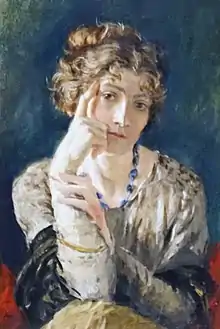Henriette Negrin
(Adèle) Henriette Negrin, (or Nigrin), born on October 4, 1877 in Fontainebleau, died in 1965 in Venice, was a French clothes-designer and textile arts artist. She created fabrics and clothes, and worked alongside her husband Mariano Fortuny.

Biography
Henriette Negrin met Mariano Fortuny in Paris at the beginning of the 20th century and, in 1902, went to live with him in Venice at the Palazzo Pesaro degli Orfei, now Palazzo Fortuny, one of the museums of the city.[1]
Henriette Negrin and her husband shared an interest for textile creations. In particular, she researched pigments for the dying of fabrics, applying the dyes herself[2] to the wood stencils for printing the textiles. Together, they developed a pleating machine the patent for which was filed by the National Institute of Industrial Property (France) of Paris on June 10, 1909. In a signed hand-written note on a copy of the patent (copy kept at the Marciana Library), Mariano Fortuny acknowledged his future wife as the inventor of the machine: " Ce brevet est de la propriété de Madame Henriette Brassart[3] qui est l’inventeur. J’ai pris ce brevet en mon nom pour l’urgence du dépôt." ("This patent is the property of Madame Henriette Brassart[3] who is the inventor. I submitted this patent in my name given the urgency of filing").[4]
This pleating technique plays a central role in the design of the Delphos gown, whose creation Henriette Negrin confirmed as her own[4] in a letter to Elsie McNeill Lee, at the time the exclusive distributor of the Fortuny fabrics and dresses in the United States.[5] In the letter, Henriette Negrin indicated her decision to terminate all production of the dress that she had designed.
During the 47 years of her life with Mariano Fortuny, Henriette Negrin was fully involved in all aspects of their creative life. After his death, she curated her husband's art collection, donating works to several museums and compiling the inventory of the contents of their residence. She donated the building to the city of Venice, which came into its full possession after her death in 1965.
References
- Palazzo Fortuny museum site
- Henriette Fortuny: ritratto di una musa, La Donna dietro l'Artista, p.9
- Brassart was the name of Henriette's mother
- Bañares, Silvia (2017). "A short biographical note on Henriette Nigrin, creator of Delphos" (PDF). Datatèxtil. No. 36. pp. 73–84. Retrieved 3 December 2017.
- Fortuny company history